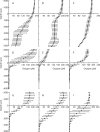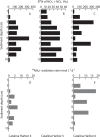Quantification of ammonia oxidation rates and the distribution of ammonia-oxidizing Archaea and Bacteria in marine sediment depth profiles from Catalina Island, California
- PMID: 22837756
- PMCID: PMC3403348
- DOI: 10.3389/fmicb.2012.00263
Quantification of ammonia oxidation rates and the distribution of ammonia-oxidizing Archaea and Bacteria in marine sediment depth profiles from Catalina Island, California
Abstract
Microbial communities present in marine sediments play a central role in nitrogen biogeochemistry at local to global scales. Along the oxidation-reduction gradients present in sediment profiles, multiple nitrogen cycling processes (such as nitrification, denitrification, nitrogen fixation, and anaerobic ammonium oxidation) are active and actively coupled to one another - yet the microbial communities responsible for these transformations and the rates at which they occur are still poorly understood. We report pore water geochemical (O(2), [Formula: see text], and [Formula: see text]) profiles, quantitative profiles of archaeal and bacterial amoA genes, and ammonia oxidation rate measurements, from bioturbated marine sediments of Catalina Island, California. Across triplicate sediment cores collected offshore at Bird Rock (BR) and within Catalina Harbor (CH), oxygen penetration (0.24-0.5 cm depth) and the abundance of amoA genes (up to 9.30 × 10(7) genes g(-) (1)) varied with depth and between cores. Bacterial amoA genes were consistently present at depths of up to 10 cm, and archaeal amoA was readily detected in BR cores, and CH cores from 2008, but not 2007. Although detection of DNA is not necessarily indicative of active growth and metabolism, ammonia oxidation rate measurements made in 2008 (using isotope tracer) demonstrated the production of oxidized nitrogen at depths where amoA was present. Rates varied with depth and between cores, but indicate that active ammonia oxidation occurs at up to 10 cm depth in bioturbated CH sediments, where it may be carried out by either or both ammonia-oxidizing archaea and bacteria.
Keywords: amoA; archaea; bioturbation; nitrification; sediments.
Figures




References
-
- Abell G. C. J., Revill A. T., Smith C., Bissett A. P., Volkman J. K., Robert S. S. (2010). Archaeal ammonia oxidizers and nirS-type denitrifiers dominate sediment nitrifying and denitrifying populations in a subtropical macrotidal estuary. ISME J. 10 286–300 - PubMed
-
- Aller R. C. (1982). “The effects of macrobenthos on chemical properties of marine sediment and overlying water,” in Animal–Sediment Relations (2): Topics in Geobiology eds McCall P. L. M., Tevesz J. S. (New York NY:Plenum Press; ) 53–96
-
- Beman J. M., Popp B. N., Alford S. E. (2012). Quantification of ammonia oxidation rates and ammonia-oxidizing archaea and bacteria at high resolution in the Gulf of California and eastern tropical North Pacific Ocean. Limnol. Oceanogr. 57 711–726
LinkOut - more resources
Full Text Sources

